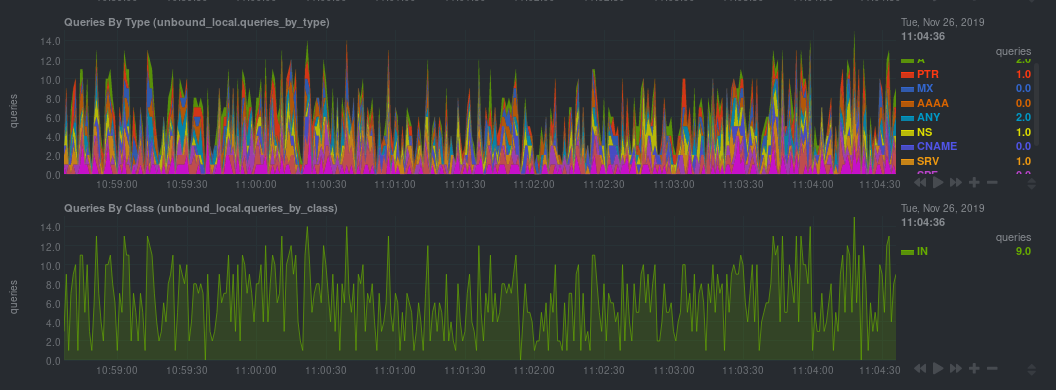<!--
title: "Monitor Unbound DNS servers with Netdata"
sidebar_label: "Monitor Unbound DNS servers with Netdata"
date: 2020-03-31
custom_edit_url: https://github.com/netdata/netdata/edit/master/docs/guides/collect-unbound-metrics.md
learn_status: "Published"
learn_topic_type: "Tasks"
learn_rel_path: "Miscellaneous"
-->
# Monitor Unbound DNS servers with Netdata
[Unbound](https://nlnetlabs.nl/projects/unbound/about/) is a "validating, recursive, caching DNS resolver" from NLNet
Labs. In v1.19 of Netdata, we release a completely refactored collector for collecting real-time metrics from Unbound
servers and displaying them in Netdata dashboards.
Unbound runs on FreeBSD, OpenBSD, NetBSD, macOS, Linux, and Windows, and supports DNS-over-TLS, which ensures that DNS
queries and answers are all encrypted with TLS. In theory, that should reduce the risk of eavesdropping or
man-in-the-middle attacks when communicating to DNS servers.
This guide will show you how to collect dozens of essential metrics from your Unbound servers with minimal
configuration.
## Set up your Unbound installation
As with all data sources, Netdata can auto-detect Unbound servers if you installed them using the standard installation
procedure.
Regardless of whether you're connecting to a local or remote Unbound server, you need to be able to access the server's
`remote-control` interface via an IP address, FQDN, or Unix socket.
To set up the `remote-control` interface, you can use `unbound-control`. First, run `unbound-control-setup` to generate
the TLS key files that will encrypt connections to the remote interface. Then add the following to the end of your
`unbound.conf` configuration file. See the [Unbound
documentation](https://nlnetlabs.nl/documentation/unbound/howto-setup/#setup-remote-control) for more details on using
`unbound-control`, such as how to handle situations when Unbound is run under a unique user.
```conf
# enable remote-control
remote-control:
control-enable: yes
```
Next, make your `unbound.conf`, `unbound_control.key`, and `unbound_control.pem` files readable by Netdata using [access
control lists](https://wiki.archlinux.org/index.php/Access_Control_Lists) (ACL).
```bash
sudo setfacl -m user:netdata:r unbound.conf
sudo setfacl -m user:netdata:r unbound_control.key
sudo setfacl -m user:netdata:r unbound_control.pem
```
Finally, take note whether you're using Unbound in _cumulative_ or _non-cumulative_ mode. This will become relevant when
configuring the collector.
## Configure the Unbound collector
You may not need to do any more configuration to have Netdata collect your Unbound metrics.
If you followed the steps above to enable `remote-control` and make your Unbound files readable by Netdata, that should
be enough. Restart Netdata with `sudo systemctl restart netdata`, or the [appropriate
method](/packaging/installer/README.md#maintaining-a-netdata-agent-installation) for your system. You should see Unbound metrics in your Netdata
dashboard!

If that failed, you will need to manually configure `unbound.conf`. See the next section for details.
### Manual setup for a local Unbound server
To configure Netdata's Unbound collector module, navigate to your Netdata configuration directory (typically at
`/etc/netdata/`) and use `edit-config` to initialize and edit your Unbound configuration file.
```bash
cd /etc/netdata/ # Replace with your Netdata configuration directory, if not /etc/netdata/
sudo ./edit-config go.d/unbound.conf
```
The file contains all the global and job-related parameters. The `name` setting is required, and two Unbound servers
can't have the same name.
> It is important you know whether your Unbound server is running in cumulative or non-cumulative mode, as a conflict
> between modes will create incorrect charts.
Here are two examples for local Unbound servers, which may work based on your unique setup:
```yaml
jobs:
- name: local
address: 127.0.0.1:8953
cumulative: no
use_tls: yes
tls_skip_verify: yes
tls_cert: /path/to/unbound_control.pem
tls_key: /path/to/unbound_control.key
- name: local
address: 127.0.0.1:8953
cumulative: yes
use_tls: no
```
Netdata will attempt to read `unbound.conf` to get the appropriate `address`, `cumulative`, `use_tls`, `tls_cert`, and
`tls_key` parameters.
Restart Netdata with `sudo systemctl restart netdata`, or the [appropriate
method](/packaging/installer/README.md#maintaining-a-netdata-agent-installation) for your system.
### Manual setup for a remote Unbound server
Collecting metrics from remote Unbound servers requires manual configuration. There are too many possibilities to cover
all remote connections here, but the [default `unbound.conf`
file](https://github.com/netdata/netdata/blob/master/src/go/collectors/go.d.plugin/config/go.d/unbound.conf) contains a few useful examples:
```yaml
jobs:
- name: remote
address: 203.0.113.10:8953
use_tls: no
- name: remote_cumulative
address: 203.0.113.11:8953
use_tls: no
cumulative: yes
- name: remote
address: 203.0.113.10:8953
cumulative: yes
use_tls: yes
tls_cert: /etc/unbound/unbound_control.pem
tls_key: /etc/unbound/unbound_control.key
```
To see all the available options, see the default [unbound.conf
file](https://github.com/netdata/netdata/blob/master/src/go/collectors/go.d.plugin/config/go.d/unbound.conf).
## What's next?
Now that you're collecting metrics from your Unbound servers, let us know how it's working for you! There's always room
for improvement or refinement based on real-world use cases. Feel free to [file an
issue](https://github.com/netdata/netdata/issues/new?assignees=&labels=bug%2Cneeds+triage&template=BUG_REPORT.yml) with your
thoughts.